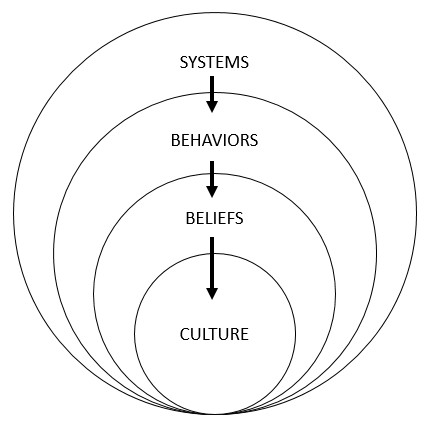An organization’s culture is created from beliefs. These beliefs are formed through daily behaviors and the responses to these behaviors. And the behaviors are typically driven by the systems embedded in the organization. So when change is desired, there are 3 points of entry to begin the transformation, each with pros and cons.
Systems -> Behaviors -> Beliefs -> Culture
Leadership typically and unfortunately starts from what they perceive is the easiest but is actually the most complex – Employee Beliefs. The most common ways you’ve probably seen are by handing down edicts where employees are told to to do or not do something. Posters and new mission statements often appear in an effort to motivate or inspire along with catchphrases and the like. These commands, words and billboards are routinely dismissed and or mocked as toothless reminders of corporate paternalism. However, this approach isn’t typically done in isolation, it is coupled with another point of entry, behaviors.
Directly addressing employee Behaviors is the next level up effort but again will typically fall short of lasting change. Behavior change is often driven by informational training and/or incentive programs to bring about new attitudes and behaviors or remove unwanted ones. These efforts can work temporary because the training is often unsupported by management and incentives are rarely made permanent. When both evaporate, it’s back to status quo. These approaches are commonly used by leadership because they will see fast but sadly only temporary change. It’s akin to a quick hit which is highly addictive with no lasting impact.
The final entry point is the only one that doesn’t directly target employees and is the path rarely taken because it can shake the landscape. Systems Change is indirect behavior change and it is the element in an organization that has the greatest influence on the previous two. Systems change efforts can be Catalytic Mechanisms because of the far reaching and sometimes unexpected transformation they bring. It is a scary proposition for the status quo but ultimately it is the systems that drive behaviors and behaviors are what create beliefs, and the beliefs form the culture.
Take for example an organization’s intertwined systems of communication and trust. Trust takes on different forms based on communication beliefs. When communication is closed and top-down, Managers direct and employees act. Managers subsequently trust only those that comply and employees trust that if they comply, they will be rewarded. A culture of compliance is born. It’s easy, clean but hardly advances the organization. If however we have open communication where Managers trust employees to be autonomous, do what is necessary and get what they need, then environments where networks thrive and information moves uninhibited are created. This is fertile soil for retention, creativity and innovation but it can be painful for the traditional hierarchy.
Systems, Behaviors, Beliefs. Where does your organization begin change efforts?


